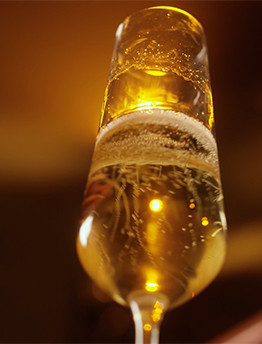Production
We are the only ones in Kazakhstan and Central Asia who make sparkling wine by classic “Champenoise” technology and “Cuvee” method. The whole process takes place inside bottles. The most entitled and expensive wines in the world are made by this technology. It is a long-term and complex process of after fermentation invented by French winemakers. For the first time in the country the method was implemented by “Bacchus” in 1948.
01
01

Harvest grapes and make grape mash
From the grapes grown at our plantations in Almaty region we make the grape mash. It is important not to lose a single drop of this precious liquid. That’s why we harvest the grapes manually and put them into small boxes without crushing the soft bunches.
02
02

Send mash to fermentation
The grape mash ferments inside special reservoirs of stainless steel or coated with glass enamel on the inner face. During this very process the alcohol is formed in the liquid and the grape juice turns into wine.
03
03

Remove the sediment from the wine material
When the mash finishes its fermentation, the yeast deposit flocculates. We carefully pour the liquid into another vessel — take away from the sediment, filter, clarify and prepare it for the blending.
04
04

The prepared wine material is sent to the plant
05
05

Blending. Mix the varieties
Before the process of afterfermentation, we blend wines of different years and varieties. That’s how we manage to create the unique flavor and put the emphasis on fortes of the wines. This process is called blending.
06
06

Tirage. Bottling of the wine
We mix the blended champagne with liqueur and pure yeast cream. Then the triaged mix is carefully bottled, sealed with corks and clips. The long-term processes of afterfermentation and riddling lay ahead.
07
07

Put to afterfermentation
We lay bottles of wine in rows on fermentation stacks for 9 months. During this time each bottle gets re-laid thrice, it also gets shook and put on a new stack.
08
08
Re-lay bottles
After nine months bottles are put into the cold-treatment camera with the temperature of -2−3°С for 3−5 days for the stabilization of wine.
09
09
Remuage. Rotate bottles for riddling
We put bottles necks down at a certain angle on easels — holders with holes. The man of a unique job, remueur, daily gives each bottle a 45 degrees turn gradually increasing the inclination so sediments eventually end on a cork. A remueur turns 12 000 bottles per day.
10
10
Disgorging. Removing the cork with sediments
We freeze the neck of the bottle so sediments turn into an ice cork which is to be removed or «blown away” along with the tirage cork.
11
11
Cork the bottle
Every bottle is sealed with a cork stopper. The top of the cork is fixed with a muselet, a wire cage. Legend has it that Widow Clicquot made the first muselet from the wire of her corset. Usually muselet is 50 up to 80 cm long.
Reservoir periodic method of champagnization is a modern way to produce champagne. The process is as follows: the wine material ferments in a closed hermetically sealed device called acratophore under the gradually increasing pressure of carbon dioxide.
01
01

Harvest grapes and make grape mash
From the grapes grown at our plantations we make the grape mash. It is important not to lose a single drop of this precious liquid. That’s why we harvest the grapes manually and put them into small boxes without crushing the soft bunches.
02
02

Send mash to fermentation
The grape mash ferments inside special reservoirs of stainless steel or coated with glass enamel on the inner face. During this very process the alcohol for which wine is praised is formed, and the grape juice becomes wine.
03
03

Remove the sediment from the wine material
When the fermentation of mash is over, the yeast deposit flocculates. We carefully pour the liquid into another vessel — take the sediment away, filter, clarify and prepare the liquid for the blending.
04
04

The prepared wine material is sent to the plant
05
05

Put the wine material to rest
The material is forwarded to the plant. After transportation it «rests” there for several days.
06
06

Fining the wine
Fining is a technological method of removing suspended particles from the wine material, which provides the clarification of the wine and prevents the potential cloudiness by injecting solutions of fining substances into the wine. After this procedure the wine gets more stable and transparent.
07
07

Filtering wine
After the fining we filter the liquid to remove sediments completely.
08
08

Blending wine
Before bottling we blend wines of different years and varieties. That’s how we manage to create the exclusive race of wine and put the emphasis on its fortes.
09
09

Champagnization
The wine is sent to afterfermentation so the drink gets fizzy and our beloved bubbles appear. To make semi-dry semi-sweet champagne wines we add the dosage liqueur for our champagne to get the unique flavor, and then we send it to the control filtering.
10
10

Bottling champagne
Clean bottles that undertook meticulous cleansing and test for defects get filled with the wine at the temperature less than five degrees. Then the inspection takes place — we painstakingly observe each bottle over the light screen so we won’t miss any flaw. We carefully bottle the wine, seal them with corks, fix corks with wire muselet and forward bottles to stores.
Visit us for a tour
The cost of the tour is 20 000 KZT for a group. The group can include up to 10 persons. If you want to have a tour, please, write or call 392 22 54.
Thank you!
We will contact you
